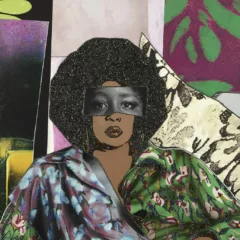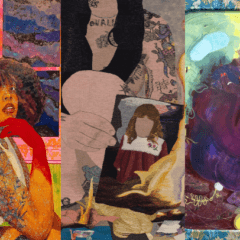Some of what’s on view at Vox Populi this month is mystifying and theory-driven; some is digitally-savvy and soulful, and some is digitally-savvy and formalist. Happily, there’s also a piece that is downright lovable in the up-from-the-basement DIY way.
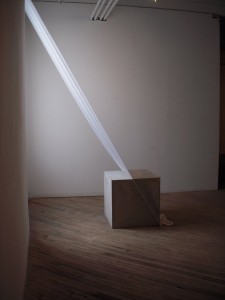
Zack Rockhill, whose work I’ve seen before and liked, serves up an incomprehensible video accompanied by a couple of actually very nice sculptures. The oeuvre is laid at the altar of, quoting, “Stanley Cavell’s interpretation of Beckett’s Endgame in his book of essays Must We Mean What We Say?” I didn’t read the book but what I say is yes, Cavell, sometimes we do need to mean what we say, or mean what we make, or make what we say, whatever.
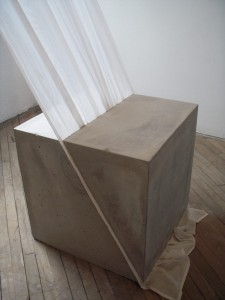
Rockhill’s video has a construction theme which goes with his cast concrete and found object sculptures to a certain degree. But construction materials are surely not the subject: and if the work is saying something about building/renewal/collapse/solidity/fragility/self/other, I just can’t catch its meaning. But as I say, thumbs up on the look of the conceptual sculptural objects, which are not only beautiful in a satisfying formalist way (who doesn’t like a cube of smooth concrete?) but which have some poetry to them as well. “Solar Void” in particular — which approximates in my mind a modern update of the old master paintings of godly rays of light from on high — is both a crunchy materials’ piece and, as a tombstone stand-in, evocative emotionally.
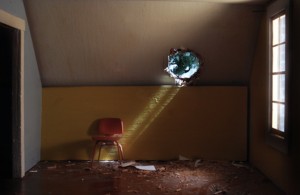
In a completely different zone of expression, Julianna Foster’s color inkjet prints from her Kirkwood series are conceptually clear. They are about families, people sharing inside space, and memories of things and emotions that once happened. Like Rockhill’s, Foster’s images, too, play with suggestions of construction and deconstruction. And one of the numbered works even echoes Rockhill’s Solar Void piece, casting heavenly rays of light into the picture from a punched out hole in the roof.
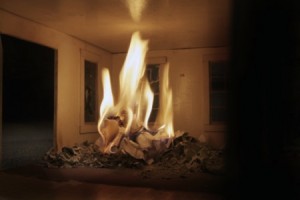
When I saw these works I immediately thought of Jeffrey Stockbridge’s scenes of empty Philly squat houses or abandoned buildings (the Divine Lorraine). But something about the claustrophobia of Foster’s spaces suggests that these are miniature — and not human-scale rooms. I will keep you guessing because that question is rather intriguing. If these are dollhouse rooms, then it is as if a naughty child lit the fires, punched the holes and caused this mess. If so, the whole thing becomes a kind of meta-revenge on the past. If instead these are human-scale rooms they are one more poetic documentation of forlorn human space.
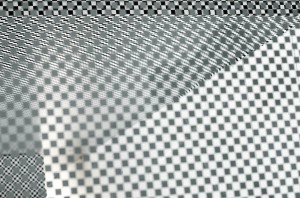
There’s nothing forlorn about Brent Wahl’s new body of work, “Group Show.” The very digitally-savvy-looking photos — all archival digital prints — are super op-pop glamorous. Installed on a band of grey paint running around the gallery walls, the body of work divides into a group of grisaille grille-like pieces and other more colorful works. Shot mostly with a 4×5 view camera and scanned from negatives, the artist says, the grisaille “scenes,” if that’s what you can call them, present what appear to be a series of screens and scrims behind which things lie. Things like shadows and maybe some objects like tables or crumpled tin foil (2011’s super art material). I kept thinking Bridget Riley thoughts as I moved between these numbered works, and yet, the op that they are is a Raymond Chandler-esque op–stylized, mysterious and urban/urbane. These works are seductive for their evocation of space and perhaps story.
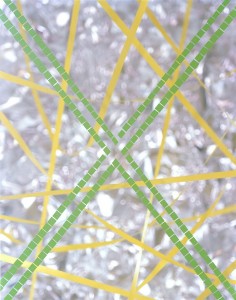
Wahl’s more colorful images are less compelling, being either documentary-like images of groups of matter or close ups of something in the real world (crumpled tin foil) captured through layers of colored masks. Whereas the grouping of grisaille works has a tight cohesion in both subject and motif (style), the colorful works are more disparate and their content is less compelling.
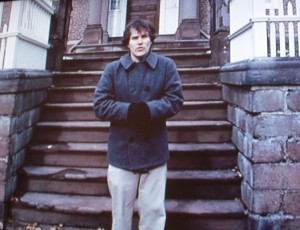
Elsewhere in Vox, a real group show, “Pull Your Coat to This,” presents four artists’ works on the theme of “group belonging.” The show, which has a RISD/Providence connection, is organized by Alee Peoples, whose “The Root that ate Roger Williams,” 2011, is the star of the show. The 18-minute film transferred to DVD describes the affinity group dedicated to the legend of Providence, RI, historical personage, Roger Williams. Williams died and was buried in a grave that was later invaded by a tree root that blasted through the casket and took over his body. It’s a legend as I say and the entire “documentary” about the affinity group is tongue in cheek serious.
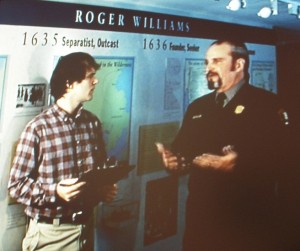
Lumpy camera work, an engaging albeit untrained narrator and hostile responses to dumb questions are some of the highlights of this hand-made and lovable hooey. I’ll take a narrative any day, no matter how wink-wink, nod-nod. And this one feels just about right. Others in the group show are Michael Bizon, Erin Zona and Anders Johnson.
Kudos to Vox — which programs like a mini-museum these days — for this nice mix of member shows and a completely unrelated but nonetheless fitting outside group show. The May exhibits are up through next Sunday, May 29.


